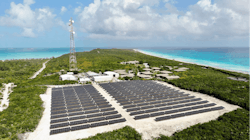Solar FlexRack's Mounting Technology Installed in Bahamas Resort Island's Solar Hybrid Microgrid
Solar FlexRack, a division of Northern States Metals and an innovative leader in photovoltaic (PV) mounting and solar tracker solutions, announced that its Fixed Tilt FlexRack Series G3-X racking solution is fully operational for Azimuth Energy’s 1.1 MW solar project on Highbourne Cay in the Bahamas as part of the Owner’s sustainability goals. This robust microgrid, which includes the largest PV array operating in the Bahamas to date, was designed to withstand up to 180 mph winds and provides reliable around-the-clock power in the face of increasingly severe hurricanes. It includes a 2 MWh battery plant that enables all resort generators to be switched off for the first time in fifty years, resulting in cleaner air and greater savings for up to 100 residents and guests at the resort at any given time.
Azimuth Energy selected Solar FlexRack’s G3-X mounting solution due to its suitability for very high wind applications, adaptability, corrosion resistance, and quick installation time. The G3-X has an efficient four-posts-per-table design, heavy corrosion protection and allows PV modules to be individually bolted, as opposed to top clamped, for maximum hurricane survivability. “We have used Solar FlexRack for dozens of projects, and we are able to install their G3-X system quickly and consistently to safeguard PV modules and our clients’ investment during drastic weather events,” said Marc Lopata, President and CEO of Azimuth Energy. “Solar FlexRack’s responsive customer service and project support are key in our product selection process.”
From providing hurricane consulting for the U.S. Department of Energy’s National Renewable Energy Laboratory (NREL) and a renowned international bank to engineering and constructing countless solar plus storage projects throughout the Caribbean over the past decade, Azimuth Energy has a long track record of demonstrating its expertise in building resilience into microgrid systems. Azimuth Energy is also a co-author of RMI’s “Solar Under Storm” best practices manual on hurricane resilience. “We were honored to have had the opportunity to work alongside Azimuth Energy on this impactful project,” said Steve Daniel, EVP of Sales and Marketing at Solar FlexRack. “Azimuth Energy is one of the industry leaders in designing and constructing long-lasting, robust solar plus storage microgrids, particularly in remote regions most vulnerable to increasingly severe hurricanes.”
Azimuth Energy also leveraged its expertise and the HOMER Energy microgrid software platform to simulate the microgrid performance and determine which system configuration would deliver the optimal levelized cost of energy (LCOE) for this site. Since the occupancy, energy consumption, PV production, and sunlight significantly vary day to day and month to month, Azimuth Energy conducted the annual performance simulation on an hour-by-hour basis to define the microgrid configuration and reduce the microgrid’s LCOE.
In addition to providing a quiet island, hurricane resilience, lower maintenance effort for island staff, and better air quality, this microgrid will also pay for itself in just five to six years due to diesel powerplant savings alone. Prior to this installation, loud, polluting, and high maintenance generators were used twenty-four-seven. In total, about two-thirds of the island’s diesel fuel consumption will be eliminated as a result of this project, saving 1,800 metric tons of carbon emissions per year. After the system has paid for itself, the island owners will continue to save more than $700,000 on operating expenses per year in addition to the significant non-financial benefits. “This project has demonstrated that it’s possible to provide environmental benefits and long-term savings through solar-plus-storage microgrids built even in the most severe climates,” said Chris Wilson, President of Bahamas Energy and Solar Supplies.
